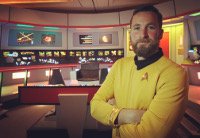James Tuttle Keane

Address:
4800 Oak Grove DriveM/S 183-601 Pasadena, CA 91109
Phone:
818.354.9036Curriculum Vitae:
Click hereWebsite:
Click hereMember of:
Small BodiesBiography
Dr. James Tuttle Keane hails from Cedar Rapids, Iowa. He received a bachelor’s degrees in Astronomy and Geology from the University of Maryland, College Park, and a doctorate in planetary science from the University of Arizona, under the mentorship of Dr. Isamu Matsuyama. After a postdoctoral position at the California Institute of Technology, he started at JPL in 2020.
Dr. Keane is a planetary scientist, studying the interactions between orbital dynamics, rotational dynamics, and geologic processes on rocky and icy worlds across the solar system. He uses a combination of theoretical methods, coupled with the analysis of spacecraft-derived datasets to investigate the dynamics, structure, origin, and evolution of solar system bodies. He has extensive experience with NASA missions, including GRAIL, New Horizons, and the proposed Io Volcano Observer.
In addition to science, Dr. Keane is an accomplished science illustrator and communicator, specializing in pen and pencil illustrations of planetary science concepts, new results, and exciting missions.
Education
- Ph.D., Planetary Science, University of Arizona (2017).
- M.S., Planetary Science, University of Arizona (2015).
- B.S., Astronomy, University of Maryland, College Park (2011).
- B.S., Geology, University of Maryland, College Park (2011).
Professional Experience
- Scientist, Jet Propulsion Laboratory (2020–present).
- Co-Investigator, Io Volcano Observer (IVO), NASA Discovery mission proposal (2018–present).
- Science Team Member, New Horizons, NASA New Frontiers mission (2017–present).
- Joint Center for Planetary Astronomy (JCPA) Postdoctoral Fellow, California Institute of Technology (2017–2020).
- Science Team Member, Gravity Recovery and Interior Laboratory (GRAIL), NASA Discovery mission (2014–2017).
- Graduate Research Associate, Department of Planetary Science, University of Arizona (2013–2017).
- Graduate Research/Teaching Assistant, Department of Planetary Science, University of Arizona (2011–2013).
- Undergraduate Teaching Assistant, Department of Astronomy, University of Maryland, College Park (2008–2010).
Community Service
- Over 30 Published Scientific Illustrations, in both peer reviewed journals (e.g., Nature Geoscience, Nature Astronomy, Icarus, JGR: Planets, etc.), and in published news articles.
- “Sketch Your Science” Workshop, co-leader, American Geophysical Union (2018–2019).
- AAS Committee for the Status of Women in Astronomy (2019–present).
- Reviewer for Publications, including: Journal of Geophysical Research: Planets, Geophysical Research Letters, Space Science Reviews, Planetary and Space Sciences, Proceedings of the National Academy of Sciences of the United States of America, University of Arizona Press, Nature Communications.
- Reviewer for NASA Grants, including: Solar System Workings (SSW), Cassini Data Analysis Program (CDAP), New Frontiers Data Analysis Program (NFDAP), Astrobiology Program, Earth and Space Science Fellowship (NESSF) program, Lunar Data Analysis Program (LDAP).
- Public speaking, outreach, volunteering, including: Strange New Worlds: A Science and Star Trek Podcast (2017–2019), Dahlia Heights Elementary School (2018), Tucson Amateur Astronomy Association (2016), Space Drafts/Art on Tap (2016), Pima Air and Space Museum (2014–2015), The Art of Planetary Science (2013–2017).
- Astronomy Camp, camp counselor, University of Arizona (2014–2016).
- Space Camp Turkey, camp counselor, İzmir, Turkey (2009).
- Association des Jeunes Engagés pour la Promotion de la Santé (AJEPS), Maroua, Cameroon (2007).
Research Interests
- The geophysics of rocky and icy bodies, including asteroids, comets, Kuiper Belt objects, dwarf planets, icy satellites, and terrestrial planets.
- Planetary gravity, topography, and geodesy.
- Planetary exploration.
Selected Awards
- Editor’s Citation for Excellence in Refereeing, Geophysical Research Letters (2018).
- Pellas-Ryder Award, Geological Society of America (2017).
- Galileo Circle Scholar, University of Arizona (2014, 2016, 2017).
- Eugene M. Shoemaker Impact Cratering Award, Geological Society of America (2016).
- Gerard P. Kuiper Memorial Award, University of Arizona (2015).
- Outstanding Student Paper Award (OSPA), American Geophysical Union (2014).
Selected Publications
- J.R. Spencer, and 76 co-authors including J.T. Keane (2020). The Geology and Geophysics of Kuiper Belt Object (485958) Arrokoth. Science, 367, eaay3999.
- W.B. McKinnon, and 27 co-authors including J.T. Keane (2020). The solar nebular origin of (486958) Arrokoth, a primordial contact binary in the Kuiper Belt. Science, 367, eaay6620.
- Bouley, S., and 11 co-authors including J.T. Keane (2020). A thick crustal block revealed by reconstructions of early Mars highlands. Nature Geoscience, 13, 105–109
- J.T. Keane & A.I. Ermakov (2019). No Evidence for True Polar Wander of Ceres from Dawn Gravity and Topography Data. Nature Geoscience, 12, 972–973.
- S.A. Stern, and 205 co-authors including J.T. Keane (2019). Initial results from the New Horizons exploration of 2014 MU69, a small Kuiper Belt Object. Science, 649, eaaw9771.
- D.P. Cruikshank, and 20 co-authors including J.T. Keane (2019). Recent Cryovolcanism in Virgil Fossae on Pluto. Icarus, 330, 158–169.
- D.P. Cruikshank, and 20 co-authors including J.T. Keane (2019). Prebiotic Chemistry of Pluto. Astrobiology, 19, 831–848.
- R.A. Beyer, and 16 co-authors including J.T. Keane (2019). The Nature and Origin of Charon’s Smooth Plains. Icarus, 323, 16–32.
- O.L. White, and 15 co-authors including J.T. Keane (2019). Washboard Terrain on Pluto Evinces Ancient Glaciation. Nature Astronomy, 3, 62–68.
- J.C. Andrews-Hanna, and 8 co-authors including J.T. Keane (2017). Ring faults and ring dikes around the Orientale basin on the Moon. Icarus, 3, 1–20.
- J.T. Keane, et al. (2016). Reorientation and faulting of Pluto due to volatile loading within Sputnik Planitia. Nature, 540, 90–93.
- M.T. Zuber, and 27 co-authors including J.T. Keane (2016). Gravity field of the Orientale Basin from the Gravity Recovery and Interior Laboratory Mission. Science 354, 438–441.
- B.C. Johnson, and 13 co-authors including J.T. Keane (2016). Formation of the Orientale Lunar Multi-Ring Basin. Science, 354, 441–444.
- I.Matsuyama, I. and 7 co-authors including J.T. Keane (2016). GRAIL, LLR, and LOLA constraints on the interior structure of the Moon. GRL, 43, 8365–8375.
- M.A. Siegler, and 6 co-authors including J.T. Keane (2016). Lunar true polar wander inferred from polar hydrogen. Nature, 531, 480–484.
- J.T. Keane and I. Matsuyama (2014). Evidence for lunar true polar wander and a past low-eccentricity synchronous lunar orbit. GRL, 41, 6610–6619.